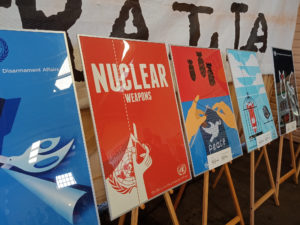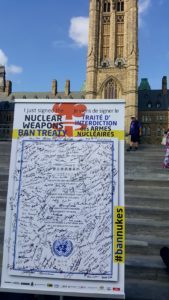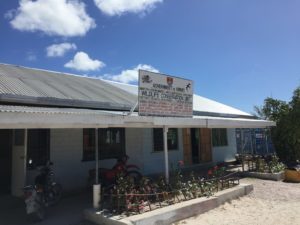For the first time in years, nuclear weapons are consistently front page news. The “will they, won’t they” of a meeting between American President Donald Trump and Kim Jong Un of the Democratic People’s Republic of Korea (DPRK) dominated the news cycle for weeks. Nuclear politics is back in a big way with intemperate tweets, cancelled non-proliferation agreements, summits and nuclear tests. Not since the Cold War has the threat of nuclear weapons been this obvious. Underlying this return to this politics of death is a simple fact – the risk of an intentional or accidental nuclear war has been threatening our lives and planet every day since 1945. We have never stepped out from under JFK’s nuclear sword of Damocles.
Humanity is facing two existential threats – climate change and nuclear weapons. Climate change is happening slowly and could be halted, but the damage from nuclear weapons will be immediate and irreversible.
A single nuclear weapon detonated in a major city could kill millions and continue to cause harm to people and the environment for decades. The humanitarian community knows that no relief efforts will be possible in the face of a nuclear detonation, no state, agency or international organization has the capacity to respond to the devastation caused by a nuclear weapon. A limited nuclear exchange is predicted to result in a global famine that would kill two billion people due to the soot deposited in the atmosphere. That soot would alter temperatures and decrease food production around the world. Costs would skyrocket and the most vulnerable people who are already malnourished or food insecure would no longer be able to afford food. As food prices increase and famine sets in, people will be forced to migrate to survive thus increasing pressure on the few areas still able to produce food.

While the international community is taking steps to address climate change, there are significantly fewer plans to address the threat posed by nuclear weapons. This lack of action is problematic because nuclear weapons also hamper other global efforts like the Sustainable Development Goals (SDGs). As a universal call to action to end poverty, protect the planet and ensure that all people enjoy peace and prosperity, the SDGs set an ambitious and inclusive agenda for development. All states have committed to working towards these targets by 2030. However, a commitment to the SDGs is completely incompatible with the use, development or possession of nuclear weapons or the reliance on nuclear deterrence.
As mentioned above, a limited nuclear conflict would have disastrous consequences for global development. Global famine would make the achievement of the SDGs impossible. Clearly, the SDGs around reducing poverty and hunger, increasing health and human rights, and building economic security for all would see dramatic declines in a situation where the majority of the planet is struggling to feed themselves.
The SDGs focused on environmental protection would be out of reach due to the climate disruption while the radiation and fall out of nuclear weapons have a long documented impact on land and marine flora and fauna.
Even if nuclear weapons are never used again, their continued existence hinders the achievement of the SDGs. Currently, billions of dollars are being poured in the production, development and modernization of nuclear weapons. For example, it is estimated that the United States alone will spend approximately $348 billion on its nuclear arsenal over the next decade. That is about $35 billion a year or $95 million a day. The total estimated cost of deploying and modernising American nuclear arsenal is more than $1.2 trillion over the next 30 years not including environmental liabilities (currently, these are over half a trillion dollars). Meanwhile in, the United Kingdom, the modernization of their nuclear arsenal is estimated to cost at least £31 billion ($41.6 billion) in addition to the operating costs of the current systems which is thought to be around £2 billion a year.
There are varying estimates of how much China, the Democratic People’s Republic of Korea, France, India, Israel, Pakistan and Russia spend annually on their nuclear weapons all of which are in the billions of US dollars. Investment in nuclear weapons is not limited to the governments of nuclear armed states. Financial institutions in 24 different countries made more than $525 billion available to publicly held nuclear weapon producing companies between 2014 and 2017. Globally the amount of money expected to be spent on nuclear weapons over the next few decades should be counted in billions and trillions of US dollars.

In contrast to the vast sums of money being sunk into nuclear weapons, the amount of money spent on achieving the SDGs is quite modest. Net official development assistance by members of the Organisation for Economic Co-operation and Development (OECD) Development Assistance Committee was merely $146.6 billion in 2017. The OECD Development Assistance Committee includes 29 states compared to the 9 nuclear armed states.
The world needs more investment in sustainable development if we are going to reach the Sustainable Development GoalsSDGs. The World Health Organization reports that “achieving the SDG health targets would require new investments increasing over time from an initial US$ 134 billion annually to $371 billion by 2030.” All SDGs will require additional investments but some of those funds are currently being squandered on nuclear weapons. Even if they are not used again, nuclear weapons have a negative impact on global progress towards the SDGs by diverting much needed funding.
These threats to global progress have not gone unnoticed. The impact of nuclear weapons on sustainable development and humanity was one of the motivators of the Humanitarian Initiative on Nuclear Weapons meetings which eventually lead to the negotiation of the Treaty on the Prohibition of Nuclear Weapons in 2017.
The Treaty is grounded in humanitarian concerns about nuclear weapons and therefore is strongly related to the SDGs. As states begin to ratify and implement the Treaty, we expect to see progress towards the SDGs.
The General Obligations in Article 1 outline the core prohibitions of the treaty including prohibitions on production, transfer, stockpiling, testing and use. Since these prohibitions are aimed at preventing future nuclear weapons explosions and related casualties, humanitarian harm and environmental harm, a number of SDGs have direct connections. In particular:
SDG 3 “Ensure healthy lives and promote well-being for all at all ages,”
SDG 6 “Ensure availability and sustainable management of water and sanitation for all,”
SDG 14 “Conserve and sustainably use the oceans, seas and marine resources for sustainable development” and
SDG 15 “Protect, restore and promote sustainable use of terrestrial ecosystems, sustainably manage forests, combat desertification, and halt and reverse land degradation and halt biodiversity loss” are especially relevant to the prohibition of the use or testing of nuclear weapons.
In addition, new international humanitarian law furthers SDG 16 “Promote peaceful and inclusive societies for sustainable development, provide access to justice for all and build effective, accountable and inclusive institutions at all levels.”
The prohibition on developing, producing, and manufacturing nuclear weapons in Article 1(a) will begin to limit the resources (financial and scientific) devoted to nuclear arsenals while the prohibition on assistance with those actions will limit private sector investment in nuclear weapons producers.
As explored previously, a reduction in spending on nuclear weapons could allow more funding and research to be devoted to the Sustainable Development Goals. It is possible that prohibiting the development, production and manufacturing of nuclear weapons will contribute to progress on a number of SDGs including SDG 1 “End poverty in all its forms everywhere”, SDG 2 “End hunger, achieve food security and improved nutrition and promote sustainable agriculture” and SDG 10 “Reduce inequality within and among countries” in particular.

The positive obligations outlined in Articles 6 and 7 of the Treaty when implemented will have the most direct impact on the realization of the SDGs. When implemented, Article 6(1) on assistance to individuals affected by nuclear weapons use or testing will have a direct impact on SDG 16 regarding Peace, Justice and Strong Institutions by filling the legal gap in regards to nuclear weapons and by promoting the rights of those affected. Obligations regarding assistance to individuals affected by nuclear weapons use and testing will further contribute to the achievement of SDG 3 on Good Health and Well-Being, especially due to the principle of non-discrimination in the text. The non-discrimination principle means that citizens with similar needs should receive similar services regardless of the cause so improving services to victims of nuclear weapons use and tests should improve services to all citizens with similar needs. Assistance that is implemented in an age- and gender-sensitive manner can contribute to SDG 5 “Achieve gender equality and empower all women and girls” by addressing the current health impacts of nuclear weapons detonations which disproportionately affect women and girls.
Article 6(2) regarding environmental remediation will contribute to the realization of a number of Sustainable Development Goals. The implementation of environmental remediation provisions in the prohibition treaty will have the greatest impact on SDGs 14 on Life below Water and 15 on Life on Land as attempts to clean up contamination on land and in the oceans may restore damaged ecosystems or at minimum mitigate the ongoing damage to these ecosystems. There is significant evidence that contamination from the use and testing of nuclear weapons has had an impact on land and marine flora and fauna in addition to rendering wide stretches of land inaccessible. If land can be made safe for sustainable use, environmental remediation may contribute to realizing the targets of SDG 2 on hunger, food security and sustainable agriculture. Environmental remediation will also have an impact on SDG 3 on Good Health and Well-Being as well as SDG 6 regarding Clean Water and Sanitation. Finally, Article 7’s provisions on international cooperation echo SDG 17 (Strengthen the means of implementation and revitalize the global partnership for sustainable development).
The continued existence of nuclear weapons threatens global progress toward the Sustainable Development Goals. Any new use of nuclear weapons would all but guarantee that the world will fail to meet the SDGs while the ongoing maintenance and modernization of nuclear arsenals continues to divert scare resources away from programs supporting the SDGs.

If the international community truly wants to make progress towards the SDGs, then nuclear weapons must be eliminated. Recent history has shown that the best way to eliminate a weapon is to prohibit if first. We cannot build a better world for all with the nuclear sword of Damocles hanging over our heads constantly. States that are truly committed to the SDGs should take meaningful steps towards the elimination of nuclear weapons starting with signing and ratifying the Treaty on the Prohibition of Nuclear Weapons.
Editors Note: The opinions expressed here by Impakter.com columnists are their own, not those of Impakter.com — In the Featured Photo: The Moment of Adoption. Featured Photo Credit: Clare Conboy ICAN










